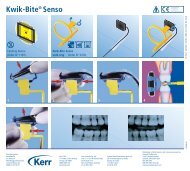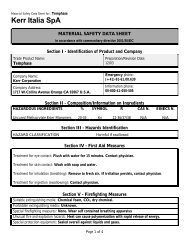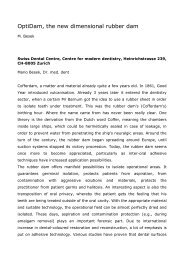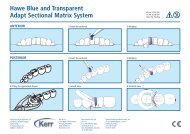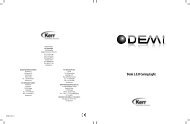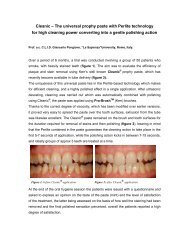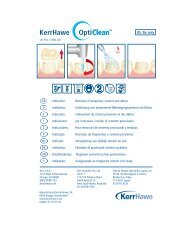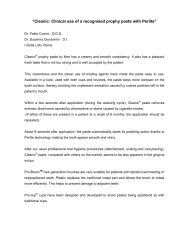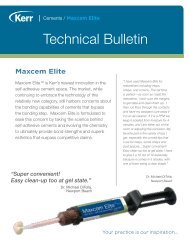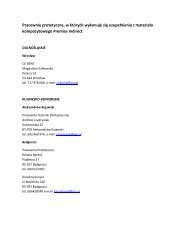Restorative Procedure - Kerr Hawe
Restorative Procedure - Kerr Hawe
Restorative Procedure - Kerr Hawe
Create successful ePaper yourself
Turn your PDF publications into a flip-book with our unique Google optimized e-Paper software.
Tungsten carbide finishing burs vary with respect<br />
to the number and orientation of the cutting flutes.<br />
These instruments are characterized by a limited<br />
cutting efficiency and achieve a smooth composite<br />
surface with only little remaining roughness [Jung,<br />
1997; Barbosa et al., 2005; Turssi et al., 2005].<br />
There is some controversy in literature, whether<br />
there are significant differences between different<br />
types of tungsten carbide finishing burs with<br />
respect to the resultant surface quality [Jung,<br />
1997; Radlanski and Best, 2007].<br />
After pre-treatment, the composite surfaces are in<br />
a variably rough state, depending on the extent<br />
and amount of corrective work and on the number<br />
and type of burs used. In order to accomplish a<br />
superior aesthetic result, maximum reduction of<br />
remaining roughness is necessary by subsequent<br />
polishing.<br />
There is a great number of polishing techniques<br />
available for application on composite restorations.<br />
Polishing systems vary with respect to shape and<br />
size of the individual instruments, number of working<br />
steps, matrix and abrasive particle composition as<br />
well as consistency.<br />
Flexible discs generally yield well smoothened<br />
composite surfaces and permit an effective<br />
reduction of remaining roughness. For this<br />
reason, flexible discs were regarded as some<br />
kind of clinical polishing standard for composite<br />
surfaces [Tjan and Clayton, 1989; Wilson et al.,<br />
1990; Hoelscher et al., 1998; Setcos et al., 1999;<br />
Roeder et al., 2000; Üctasli et al., 2007]. Because<br />
of their shape, flexible discs are efficient on even<br />
or convex surfaces; they are not recommended for<br />
application on concave or structured surfaces<br />
[Chen et al., 1988; Tjan and Clayton, 1989]. By<br />
variation of disc diameter and thickness, their<br />
application can be adapted to several clinical situations.<br />
Most disc systems are available in three or<br />
even four working steps, thus permitting a high<br />
cutting efficiency and effective roughness reduction.<br />
For this reason, flexible discs represent the<br />
only technique which can be used both for finishing<br />
and polishing.<br />
Case courtesy of Dr. Joseph Sabbagh<br />
Rubber polishers comprise a great and heterogeneous<br />
group of polishing devices. Variations in size<br />
and shape enable the application of rubber<br />
polishers both on convex and on structured or<br />
concave composite restoration surfaces. Most of<br />
the products out of this group are characterized<br />
by a rubber-like silicon matrix. The abrasive<br />
particles which are integrated into the matrix<br />
are mostly made of silicon carbide or dioxide,<br />
aluminium oxide or diamond particles in different<br />
grain sizes. The clinical application mode for the<br />
various products differs considerably. It reaches<br />
from a single-step application to two, three or four<br />
working steps. Owing to these great variations,<br />
the polishing efficiency depends strongly on the<br />
individual products used. Many systems achieved<br />
a good composite surface quality, comparable or<br />
even better than flexible discs [Jung et al., 2003;<br />
Jung et al., 2007a]. Other products caused less<br />
favourable polishing results [Ergücü and Türkün,<br />
2007; Cenci et al., 2008]. The efficiency of onestep<br />
vs. multi-step systems is still discussed in<br />
literature [Da Costa et al., 2007; Jung et al., 2007a].<br />
Polishing brushes represent a different approach<br />
towards minimizing composite roughness. Silicon<br />
carbide abrasive particles are integrated into the<br />
matrix of special synthetic filaments. This enables<br />
a universal application of polishing brushes on<br />
different types of composite surface morphology.<br />
Polishing brushes are one-step systems; their<br />
polishing efficiency is favourable, but depends<br />
on the quality of initial finishing [Krejci et al., 1999;<br />
Jung et al., 2007a].<br />
32<br />
Your practice is our inspiration.



